Finishes
Weathering Steel
Weathering steel is a method of corrosion protection and is not to be considered as a controllable "architectural finish". The nature of the coating will vary as a function of exposure to weather.
Weathering steel has the unique characteristic such that, under proper conditions, it oxidizes to form a dense and tightly adhering barrier or patina that seals out the atmosphere and retards further corrosion. This is in contrast to other steels that form a coarse, porous and flaky oxide that allows the atmosphere to continue penetrating the steel. The oxidized layer on weathering steel in many climates does not consume a significant amount of steel in its formation. However, climate is important – the oxide layer will form provided there are wet/dry cycles.
 |
Weathering steel should NEVER be positioned above concrete or any other surface that can stain. Staining is guaranteed. |
Words of caution: runoff of water from upper portions of a structure tend to produce long-lasting streaks or other patterns of redder oxide on lower portions. So, special attention must be paid to the drainage of storm water (or condensate) to prevent staining of surrounding structures, sidewalks, and other surfaces.
Weathering steel is also available in sheets, for roofing and cladding. However, they were not meant for architectural applications. Weathering steel must be kept free from debris such as leaves, pine needles, etc. These waste products retard the wet/dry cycle necessary for weathering steel and corrosion is accelerated. Also, in an accelerated environment, loss of material may be more significant, and could cause perforation of very thin sheets. In addition, for green building design, one should know that a thin weathering steel roof has low solar reflectivity, i.e. it is a "hot roof".
In terms of availability, few steel service centres will stock a large inventory of weathering steel because of its specific bridge application. However, they will order it from the mill on request but usually for bridge applications. Unfortunately, when you want to use steel for an exterior wall element, that usually represents low tonnage for a service centre.
After about two years, which is about the time it takes to develop the oxide skin, the colour is going to be much darker and reddish brown. As we are dealing with "living steel" the colour will not be consistent from project to project or even within a project. In wetter climates the colour of weathering steel will generally have an overall redder cast relative to those exposed in drier climates. However, one can be most certain that the final colour will have a rich dark earthy tone and will be low maintenance, durable and beautiful, provided one is careful about the details. If it is desired to use weathering steel in an interior application it must be noted that the requisite wet/dry cycles are absent and it will not age (very quickly). If desired it can be pre-aged outside and then installed inside. Otherwise be prepared for the final surface state to take many years to develop.
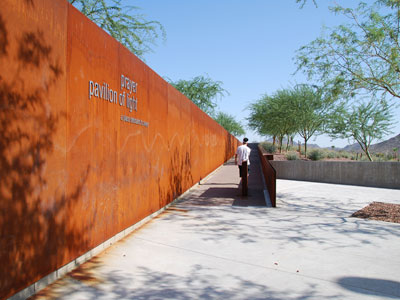 |
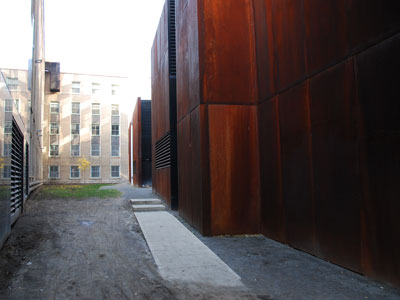 |
Staining is evident at the base of this weathering steel plate wall. Even in this desert environment, there is some rain. Also you can see wavy lines on the plate where vandals have marked the material. |
The weathering steel in this project is a darker colour as it has been exposed to more moisture. You can also see that the colour varies from panel to panel as a function of exposure. This is normal and to be expected. |
Weathering steel is not readily available in W shapes and HSS from Canadian sources. It is not appropriate for green roofs. However, it is low maintenance, no paint is required, and properly used "vertically", it can add a distinct and green character to your project.
Weathering Steel Finish is a new coating that is available for use. This is a shop and field applied "finish" that gives the appearance of weathering steel but does not create the same oxidized layer as actual weathering steel. It is applied to standard structural steel materials. It provides a similar looking finish and so might be useful where certain sizes, shapes and thickness of material are not available, or for interior settings. The coating must also be applied to site welds to result in a uniform appearance. This coating does not produce rust run off. A word of caution however if using the coating in a corrosive environment. Actual rust and deterioration of the steel will be very difficult to spot and the structure could degrade unnoticed.
Weathering steel should not be used in highly corrosive or marine environments. These locations are too aggressive for the type of protective coating that weathering steel can provide, so it will not last nearly as long.
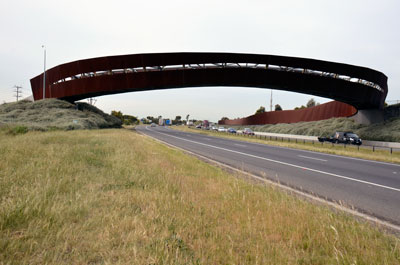 |
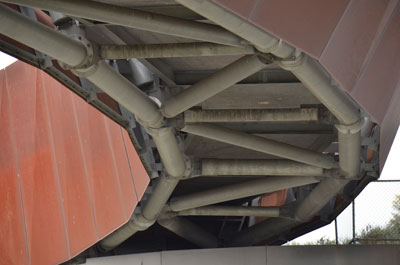 |
Weathering steel has been used as the cladding system for this pedestrian bridge in Melbourne, Australia. |
You can see the thickness (thinness) of the weathering steel side panels. Galvanized steel has been used for the primary structural system as well for its durability in this exposed setting. |
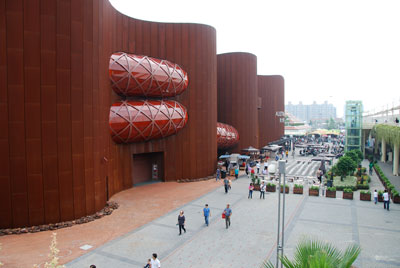 |
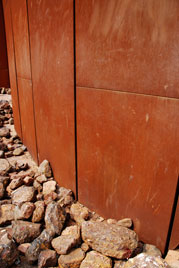 |
Weathering steel was used on the Australia Pavilion for the Shanghai Expo 2010. The cladding system is surrounded at the base by rust coloured rocks to mask any staining. Even the paving system that surrounds the building has used a rust toned paving. |
A close view of the base detail of the Expo pavilion. Even if coloured rocks are not desired, gravel can be allowed to stain and replace when the initial colouration has taken place. |
